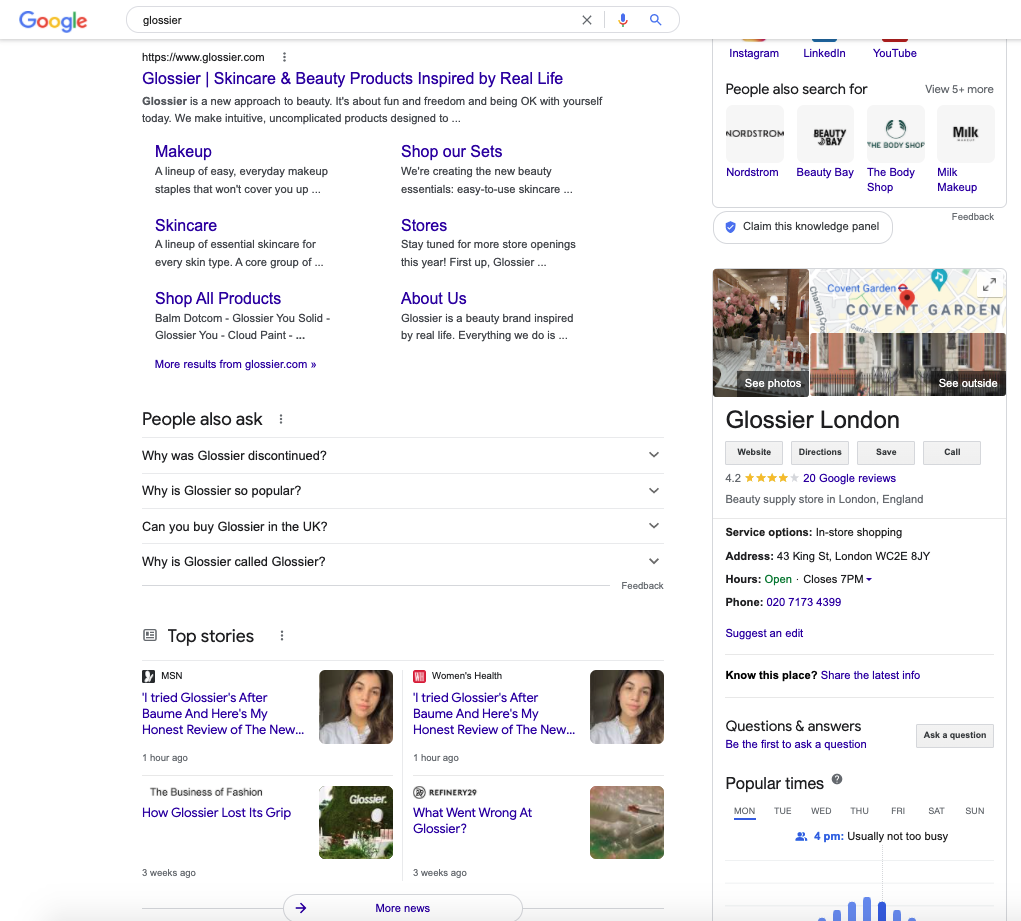The top ten mistakes that all luxury brands make online

For all businesses, the launch (or relaunch) of their products and services online promises much, but often ends in frustration.
We’ve been working with luxury brands to maximise their opportunities for business growth and development for more than 8 years. Our clients include The YOOX Group, The Maybourne Hotel Group, WP Diamonds, Creed Fragrances, Harrods, La Prairie and many more.
On the Tube this morning thinking about potential blog topics, my mind cast back to the experiences that our teams have been through with clients who are trying to find the right online balance.
Here are ten mistakes and quick fixes that we are likely to offer support with you on.
1. Not following through on your buyer personas
The content on your website and in your social media campaigns, the influencers you partner with, and the third-party sites you appear on should be driven by the findings of your buyer personas.
Buyer personas are internal documents created by product development, PR, and marketing teams to better understand the people they want to sell to.
The insights contained in a buyer persona drive:
- the decisions behind the final form of new products,
- the media partnerships created for greatest exposure, and
- marketing materials to increase revenue.
The person you serve online is the same person you serve in your retail stores and your online output needs to be centred around them and their needs.
2. Not creating enough high quality website content
Your brand’s website is a living, breathing work of commercial art which needs constant curating, updating, and expanding to achieve optimal results.
You should upload something new, of high quality, and created specifically to appeal to your target audience regularly. Any content containing information which is no longer correct should be removed or redirected. Every so often, existing and relevant content should be reviewed to look for opportunities to provide more up-to-date information.
Although important, don’t focus all of your budget for content creation to product description, imagery, and video.
That’s because buying your products and services is a lifestyle statement for many.
They’re buying the lifestyle often just as much as the product. Use your website to educate clients about your history and heritage and share with them inspirational content, style guides, and previews of things to come to draw them in even further.
3. Not prioritising SEO
There is a tendency among many companies, including luxury brands, to rely on Google to rank them first on search engine results pages when someone is looking for them. In most cases, this is fine as Google’s AI is good enough to choose the right site.
However, by focusing on keywords related just to their product range, brands are missing out on a much larger opportunity to be found by consumers that their paid, demographically-driven advertising misses.
In this article, we looked at how Tiffany’s SEO strategy means that, as well as ranking highly for terms like “tiffany necklaces”, they also finished first for “real pearl necklace”. They also scored first positions on generic terms like “women jewellery” and “jewellery collection”.
While it is true that many searchers would not be able to afford Tiffany’s jewellery, some would and, by ranking highly for non-brand related, high volume, low competition keywords, brands can expand the size of their customer database.
4. Not building internal links
Internal linking (linking from one page on your website to others within the content excluding menus) gives Google the opportunity to:
- rank content according to the importance that you ascribe to it
- better understand the content on the pages being linked to
While linking to individual products is fine, we encourage clients to link to department pages (watches, jewellery, shoes, clothes, and so on).
Clients are more likely to search for ranges of products rather than individual products when they’re in the process of coming to a decision on what they want to buy. Let visitors see your whole collection.
5. Not discovering who’s linking to your competitors
Many luxury brands’ SEO strategies involve securing backlinks (links from a third-party site to your site) to their department pages. For example, Tiffany & Co are rewarded with high rankings for non-branded, more generic terms like “women’s jewellery”.
Using tools like Ahrefs and SEMrush, you can find out which third-party sites with high domain authorities are linking back to your competitors’ department pages. Backlinks are like votes for your website – the more votes you have, the more authority Google assigns to your site.
However, some backlinks mean more than others – for example, you receive a greater benefit being linked by sites like The New York Times and Vogue than you would a relevant blogger with less than 1,000 visits a month.
Your PR and marketing teams should reach out to the websites linking to your competitors to look for opportunities to collaborate on content.
6. Not respecting the time or sensibilities of visitors
Try to minimise loading times as much as possible so that visitors don’t get bored of waiting to see the content you have for them. Google has also announced in recent months that site load speed is an important ranking factor so, if your content does not download fast enough, you will be penalised for it in the rankings.
Likewise, videos with sound or audio which runs automatically are rarely received well as is content which is difficult to navigate, especially on mobile phones.
7. Not creating a content plan for social media
Not only should brands concentrate on creating consistent, high quality content for their websites but they should do the same for their social media content.
Great social media content engages your followers and encourages them to like, comment, and share your posts with others. Your aim with social media content should be to encourage your followers to become unofficial brand ambassadors communicating your message to the world beyond your follower list.
To do this, your content needs to chime with them on a personal level. Followers need to feel that they’re important to you and that subscribing to your channel is not just an opportunity for you to sell them more products to them.
Plan and create content weeks in advance and question what value you’re adding to your followers’ lives. Extend to them exclusivity by launching follower-only competitions and giveaways. When possible, share new products and company news with followers first and let the media play catch-up for a while.
8. Not finding out which influencers your competitors are using
Influencers are social media account holders who have gained authority and respect on particular subjects with their followers, so much so that they share, comment on, and like their posts to a far higher degree than standard user accounts.
75% of luxury brands now invest in influencer marketing with 90% believing that it’s a highly effective form of marketing, according to Influencer Marketing Hub.
Brands partner with influencers to present content of interest to their followers. The value for brands in this is that they get to communicate with an audience very similar to those in their buyer personas through a voice they trust.
Influencers are talented content creators and their way of introducing, reviewing, or promoting your brand is invariably more successful than brands’ own efforts, no matter how talented their internal marketing teams are.
There is value in contacting influencers who have promoted competitors’ brands before and enjoyed high levels of engagement with sponsored posts as long as you and your competitor are targeting roughly the same audiences.
9. Not inserting yourself into the conversation on social media
Originally started on Twitter, account holders could find out what other users were talking about by prepending a hashtag before a keyword – for example, “#verbbrands”.
By monitoring hashtag usage of your brand, product names, and product categories, you can get a feel for public perception of your company and the marketplace you operate in.
You can find fans of your brand and take the opportunity to answer questions and correct any misinformation circulating about your company and its products and services by monitoring for mentions.
Consumers place a high value on getting direct responses from brands, whether they have a pre-existing loyalty or not, and you get a chance to better control the conversation about yourself.
10. Not supporting your retail network with local SEO
Brands with a retail network should focus on local SEO as more than three quarters of searches from a mobile phone result in an in-store visit.
Google Business Profiles (previously called Google My Business) allows brands to promote their local branches when people are searching for either the company or specific products and services. On them, you can contain information on opening hours, your telephone number, a link to the page for that branch on your website, product ranges, and more.
Google Business Profiles give brands the opportunity to help their branch network compete against smaller, more local operators.

Website audit from Verb Brands
In the past five years, luxury brands have become aware more than ever before about the opportunities offered by the internet to find new customers and increase revenues.
To find out more about Verb Brand’s luxury brand website auditing and for our suggestions on how you can improve your online performance, please get in touch via our contact form. We’d love to hear from you!









